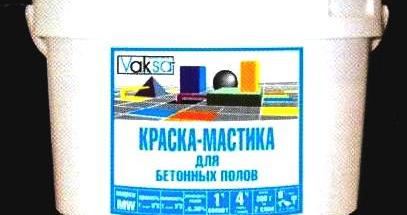Riot and variety of colors always raises a natural question: "What paint to choose?". After all, the paint that is suitable for a concrete surface, absolutely not suitable for plastering. From the right choice will depend on the quality of painting and the appearance of the surface of the ceiling, walls or floor.
Content
Working surfaces for painting
The working surfaces, which are supposed to be applied to the paint, can be conditionally divided into weakly absorbing and fast-absorbing. To weakly absorbent surfaces are concrete and plaster bases. Such surfaces need to be covered with paint and varnish materials. Paints and varnishes for surfaces should have a good enough hiding power.

The concrete surface has a relatively smooth surface. Therefore, such a surface lacks adhesion, in order to improve adhesion to the finishing finish layer. Cement plaster, on the contrary, has a rough surface structure capable of retaining the paint layer.

Such different colors
Paintwork building materials for concrete and plaster bases are divided into:
• water-borne (water-based)
• Organorastriimye (the basis is organic solvents).
Waterborne materials are based on aqueous dispersions or emulsions of synthetic resins. You will be able to verify this yourself, when you read that the composition of the paint includes acrylic, acrylate, latex and silicone.

Organosoluble materials in the composition contain alkyd or polyurethane compounds. Such substances have surface-active properties, forming characteristic films around resin particles or other organic matter. Such a protective film creates a distinctive boundary between water and the particle itself. The presence of such a border makes it possible to obtain high-quality and highly saturated paints.

Paintwork materials differ in the type of work: for the ceiling, walls or floor. Therefore choosing a paint, it does not prevent to specify for what works it is intended: for external or internal.
Select the paint for the purpose of the work you will help this video.
Paints for concrete surfaces
Paints for concrete surfaces are distinguished in the field of application: for external and internal works. The use of paint on concrete provides reliable protection of the surface from mechanical damage or wear. Select and use them is necessary when it is required to protect the concrete base from permanent exposure, thereby enhancing the longevity of the coating. Using acrylic paint for concrete, you can achieve a high degree of protection of the surface from the penetration of moisture or dust.

Any facade paint for concrete is applied to the surface in accordance with the manufacturer's recommendations. The application of paint and varnish coatings begins with the preparation of the substrate. The base is cleaned of dirt, dust and flaking remains of old materials. Then the surface is primed, allowed to dry and paint is applied over two layers.
The technology of improving the concrete surface by painting is shown in the proposed video.
When choosing a facade paint for concrete, it is necessary to clarify whether such a paint in the composition of a complex of acrylic-silicone compounds, as well as water-dispersion components. This paint has a high porosity, which significantly improves the quality of paintwork.
Acrylic paint is used to protect concrete floors in rooms with heavy load and traffic. A bright representative of the paint for the floor is the paint Betolux from Tikkurila.

Acrylic paint for concrete can be applied to the work surface in any hard temperature range, this is its advantage over other paints.

For finishing works of facades with a concrete or plaster base use water-diluted facade paints. Therefore, it will be necessary to choose acrylic or silicone facade paints. In this case, it is recommended to choose a primer also on a silicone base. In this case, the facade paint due to the enhanced adhesion of the soil will ensure an even layer.

Paints used for plaster surfaces
For paint on plastered surfaces, the following requirements must be met during the selection: this paint must have a vapor permeability and at the same time provide moisture protection to the substrate.
Paints on plaster are represented by the following types:
• Acrylic
• silicone
• silicate.

Paints with acrylic the basis is the most popular, thanks to an incredibly wide range of applications: from the ceiling to the walls. The painting of the plaster with acrylic paints is not afraid of further wet cleaning and has excellent durability. And if you add that the paint on an acrylic base, for example Arkol E, has many tones and colors (up to 690), then your choice will be justified. The only condition is that the painting of the plaster with acrylic paint requires a carefully prepared surface. Therefore, you must remove all the previous paint layers. Painting with acrylic paint is done with a roller. The roller is selected with a long pile, this allows you to have the necessary amount of paint. The painting is done in one direction, then the plaster layer will look homogeneous.

For silicone paints on plaster are typical for the presence of silicon particles in silicon resin. That's why the silicone paint has excellent hydrophobicity and atmospheric water resistance. On the surface, painted with silicone paint, almost no contaminants are formed. The dream of any mistress! Silicone paints are represented by the Atlasa range and are called Arkol N.

Silicate Paints for plasters have a base of liquid glass. They are applied to walls plastered with lime paint or painted with silicone as well as acrylic paint.
So, the right choice of paint for concrete or plastered surfaces is not complicated. Reasonably selected materials have never failed anyone.



















